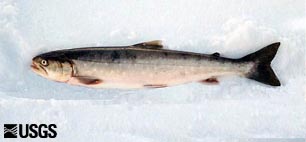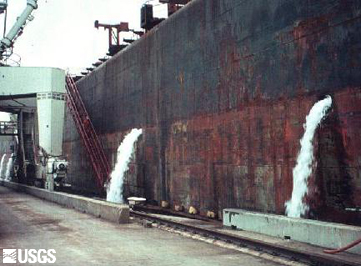- Home
- About S&T
- Taxa/Organisms
- Ecosystems
- Issues
- Methods & Tools
- Reports & Publications
- Location
- Search
October 2008 | Publisher: USGS (Soundwaves) | Format: URL
soundwaves.usgs.gov — Three years after Hurricanes Katrina and Rita ravaged the U.S. Gulf Coast, the region was hit once again by a pair of large storms: Hurricane Gustav made landfall near Cocodrie, Louisiana, on September 1, 2008, as a strong Category 2 storm; and Hurricane Ike made landfall near Galveston, Texas, on September 13, 2008, also as a strong Category 2 More...

September 2005 | Publisher: USGS (Soundwaves) | Science Center: USGS Other | Format: URL
soundwaves.usgs.gov — Biologists in the Sirenia Project at the U.S. Geological Survey (USGS) Florida Integrated Science Center (FISC) in Gainesville, FL, are currently identifying and mapping the genetic material of manatees. Their goal is to better understand and predict the manatee's ability to react to environmental stimuli, such as prolonged periods of cold More...

May 2005 | Publisher: USGS | Science Center: National Wildlife Health Center (NWHC, Madison) | Format: .PDF
www.nwhc.usgs.gov — Recent increases in the frequency and variety of infectious diseases in the southern sea otter may jeopardize the population recovery of this threatened species. This information sheet includes a list of selected publications.

Publisher: USGS | Science Center: Western Ecological Research Center (WERC, Sacramento) | Format: URL
www.werc.usgs.gov — Sea otters (Enhydra lutris) are keystone predators in the nearshore environment of the eastern Pacific Ocean, in a food web composed of sea otter, sea urchin, and kelp forest. Without sea otters, the kelp forest can be overgrazed by sea urchins, which in turn can affect other species that depend on this ecosystem. This resource provides links to More...

Publisher: USGS | Science Center: Western Fisheries Research Center (WFRC, Seattle) | Format: URL
wfrc.usgs.gov — Since 1994, scientists from the Anadromous Fish Ecology Team have been assisting the U.S. Army Corps of Engineers (USACE) in evaluating the migration behavior and passage of juvenile salmon and steelhead through Lower Granite Reservoir and Dam on the Snake River, WA. The goal of this study is to identify the behavior of individual juvenile salmon More...

Publisher: USGS | Science Center: Western Fisheries Research Center (WFRC, Seattle) | Format: URL
wfrc.usgs.gov — The Arctic charr (Salvelinus alpinus) in the northern most latitudes migrate to the ocean in the spring to feed and grow. This results in accumulation of polychlorinated biphenyls (PCB) in their visceral fat. During the winter, the charr reside in freshwater lakes and do not feed. They do mobilize lipids from adipose tissue for energy, which More...

Publisher: USGS | Science Center: Western Fisheries Research Center (WFRC, Seattle) | Format: URL
wfrc.usgs.gov — Ballast water discharges are the most significant cause of aquatic biological invasions in coastal waters, including the Great Lakes. Currently, treatment of ballast water prior to discharge at the receiving port offers significant promise to help control this problem. However, development of treatment technologies is limited by lack of objective More...

Publisher: USGS | Science Center: Western Fisheries Research Center (WFRC, Seattle) | Format: URL
wfrc.usgs.gov — Threatened and endangered salmonids in the Pacific Northwest often use backwaters and wetlands as they migrate toward the ocean, however our understanding of the role of wetlands to juvenile salmonids is limited. The major Objective of this study was to determine whether juvenile steelhead were being tapped on the wetland during spring, and More...

Publisher: USGS | Science Center: Western Fisheries Research Center (WFRC, Seattle) | Format: URL
wfrc.usgs.gov — This U.S./Russian collaboration will investigate genetics and life histories of Kamchatka Peninsula rainbow trout and steelhead (O. mykiss), and Dolly Varden, white-spotted, and arctic char (S. malma, S. leucomaensis, and S. alpinus, respectively). Both anadromous and resident forms of these generally occur in Kamchatka rivers that are free from More...

Publisher: USGS | Science Center: Western Fisheries Research Center (WFRC, Seattle) | Format: URL
wfrc.usgs.gov — Over the past 150 years, land reclamation activities have resulted in loss of significant amounts of tidal marshes (sometimes referred to as inter-tidal wetlands, the estuarine zone that is alternately flooded and exposed) in San Francisco Bay and the Sacramento-San Joaquin Delta (Bay/Delta). Recently, in an effort to halt or reverse the decline More...

Publisher: Other (San Francisco Estuary Institute (SFEI)) | Format: URL
sfei.org — The purpose of The Pulse is to make the most important information available on water quality in the San Francisco Estuary accessible to water quality managers, decision-makers, scientists, and the public. An article by USGS scientists Collin Eagles-Smith and Josh Ackerman on mercury bioaccumulation and effects on birds in San Francisco Bay More...

Publisher: USGS | Science Center: Florida Integrated Science Center (FISC, Gainesville) | Format: URL
fl.biology.usgs.gov — Coral Reefs in the Caribbean and western Atlantic are deteriorating in response to hurricanes, coral diseases, anchor damage, sedimentation, and other stresses. USGS biologists at the Caribbean Field Station are documenting the current status of coral reefs and the effects of some of these stresses. The primary objective of this issue overview is More...
